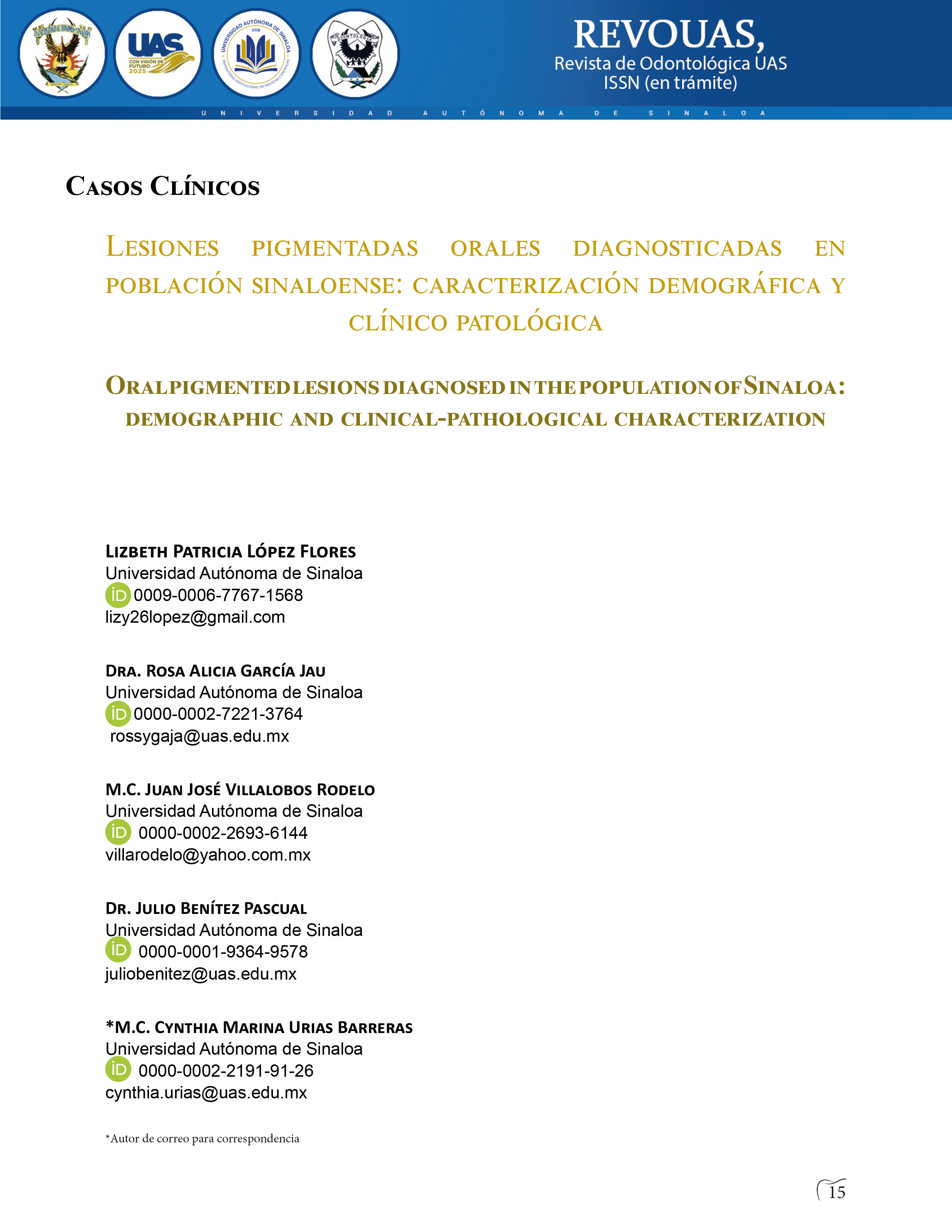Oral pigmented lesions diagnosed in the population of Sinaloa: demographic and clinical-pathological characterization
Keywords:
Melanosis, Nevus, Syndrome , Dental amalgam, MouthAbstract
Introduction. Oral pigmented lesions are rare, despite the wide range of lesions or conditions that present discoloration of oral tissues. They are classified as focal (oral melanotic macule, amalgam tattoo, melanocytic nevus, melanoacanthoma, melanotic neuroectodermal tumor of infancy, and melanoma) and diffuse or generalized (physiological pigmentation, drug-induced hyperpigmentation, smoker's melanosis, post-inflammatory pigmentation, heavy metal pigmentation, melanosis associated with systemic diseases: Addison's disease, Neurofibromatosis, Peutz-Jeghers Syndrome, McCune-Albright Syndrome, Carney Complex Syndrome, Bannayan-Ruvalcaba-Riley Syndrome). Objective. Describe the frequency and distribution of oral pigmented lesions diagnosed in the population of Sinaloa. Material and methods. Descriptive, retrospective, and cross-sectional study. All cases of oral pigmented lesions from the Center for Research and Teaching in Health Sciences, Autonomous University of Sinaloa, diagnosed from January 2014 to December 2021, were analyzed. A descriptive statistical analysis was performed, with mean value and standard deviation for numeric data, and frequencies and percentages for categorical data. Results. Twelve focal oral pigmented lesions (5 oral melanotic macules, 4 focal argyroses, 1 oral melanoacanthoma, and 2 melanocytic hyperplasias), predominantly in female gender (75%), between 21-30 (25%), 41-50 (25%) and 71-80 (25%) years of age and location in the buccal mucosa (25%) and palate (25%). Conclusions. The most frequent oral pigmented lesion was the melanotic macula, of benign nature, with a focal distribution, asymptomatic, for which a careful oral examination is crucial for its diagnosis and appropriate treatment.
Downloads
References
Álvarez M, Camacho K, Arellano A, Salgado J, Jaimes D. Investigación sobre educación para la Salud bucal en pacientes geriátricos en una población mexiquense. 2018.
De Giorgi V, Sestini S, Bruscino N, Janowska A, Grazzini M, Rossari S, et al. Prevalence and distribution of solitary oral pigmented lesions: A prospective study. J Eur Acad Dermatol Venereol. 2009 Nov;23(11):1320–3.
Fernández G, Guzmán A, Vera I. Lesiones pigmentadas de la mucosa oral. Parte I. Dermatología Cosmética, Médica y Quirúrgica. 2015;13(2):139–48.
Ferreyra R, Villanueva G, Cisneros M, Dinisio de Cabalier M. Estudio retrospectivo de lesiones pigmentarias en la cavidad bucal. Revista Argentina de Morfología. 2013;2(1):17–22.
Amérigo M, Machuca G. Tumores melanocíticos de la cavidad oral. 2017.
Aparicio M, Hernández P. Concordancia del diagnóstico clínico y el diagnóstico histopatológico de lesiones en tejidos blandos de cavidad oral. Revista Biomédica. 2021 May 1;32(2):98–105.
Albuquerque D, Cunha J, Roza A, Arboleda D, Silva A, Lopes M, et al. Oral pigmented lesions: A retrospective analysis from Brazil. Med Oral Patol Oral Cir Bucal. 2021;26(3):e284–91.
Hassona Y, Faleh S, Al-karadsheh O, Scully C. Prevalence and clinical features of pigmented oral lesions. Int J Dermatol. 2016;55(9):1005–13.
Rogério G, Rogério J, Jacks J, Lopes M, Vargas P. Oral pigmented lesions: Clinicopathologic features and review of the literature. Med Oral Patol Oral Cir Bucal. 2012 Nov;17(6):19–24.
Tavares T, Meirelles D, Aguiar M, Calderia P. Pigmented lesions of the oral mucosa: A cross‐sectional study of 458 histopathological specimens. Oral Dis. 2018;1484–91.


